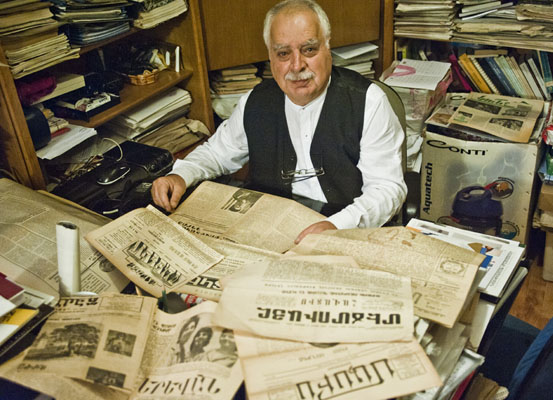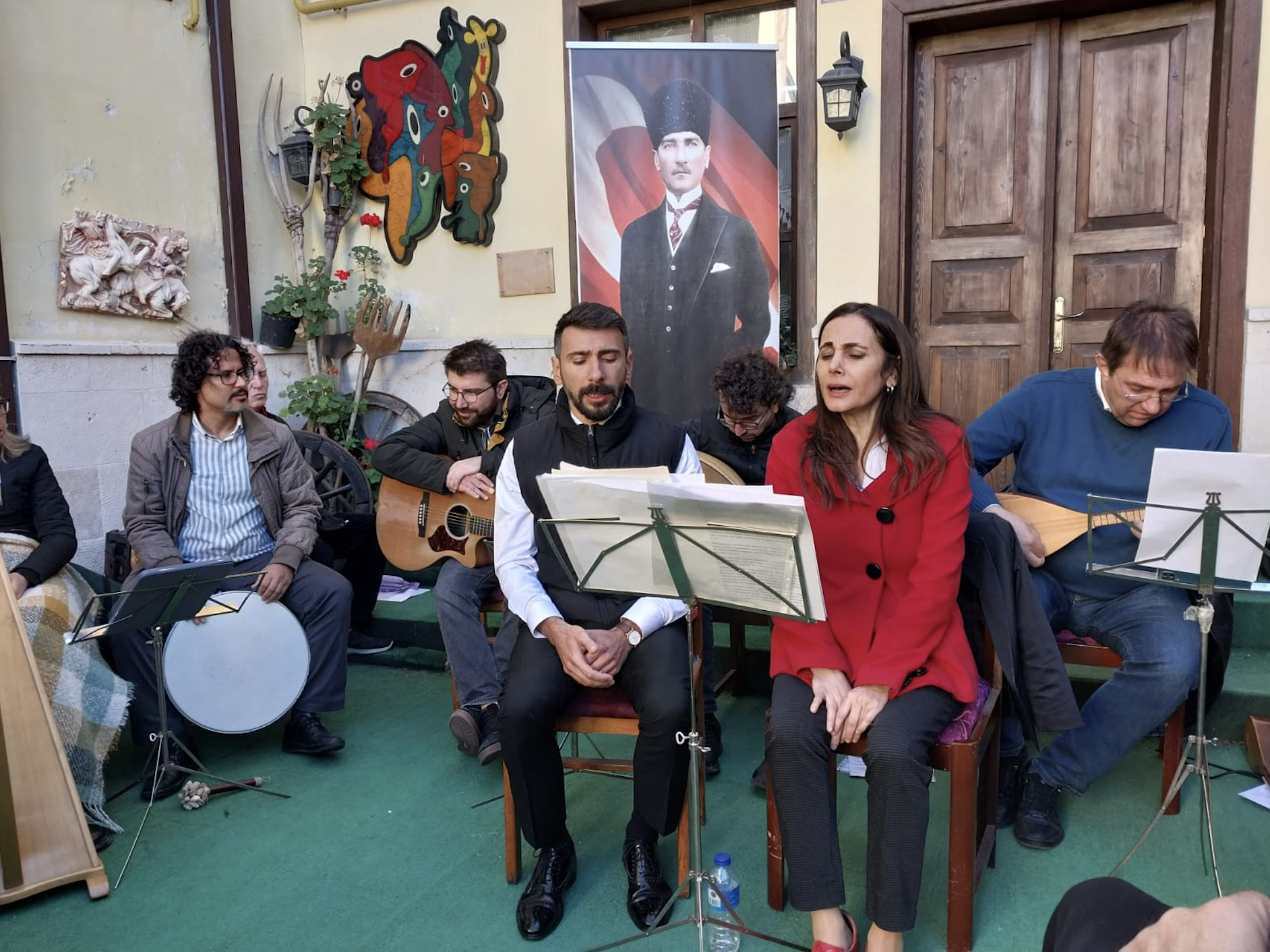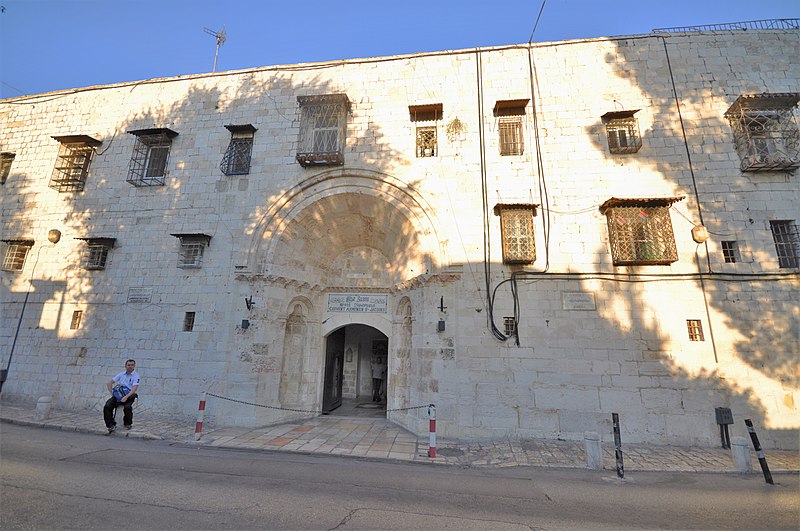Zakarya Mildanoğlu’s book ‘Armenian Periodicals 1794-2000’ has been published by Aras Yayıncılık. Mildanoğlu’s work brings together around 3650 Armenian periodicals from the year 1794, when the first Armenian newspaper Aztarar was published, until the year 2000. We talked with Zakarya Mildanoğlu about his book which is the product of around 30 years of work, and the over 200 year history of Armenian periodicals.
FERDA BALANCAR
ferda@agos.com.tr
For the book that presents to the reader in chronological order Armenian periodicals spread across a considerably broad geographical spectrum including Turkey, Armenia, Russia, the USA, Georgia, Azerbaijan, Syria, Lebanon, Italy and France, the main resource was, in addition to Mildanoğlu’s personal archive, M. A. Paployan’s work titled ‘Hay Barperagan Mamulı, Madenakidagan Hamahavak Tsutsag 1794-1980’ (Bibliography of Armenian Periodicals 1794-1980, Yerevan: Armenian Academy of Sciences, 1980). Mildanoğlu compiled descriptions of the periodicals from similar encyclopaedic and bibliographical resources and translated them into Turkish. Some of the visuals presented in the book are again from the author’s own archive, whereas others have been compiled from various Armenia and Diaspora libraries with archives of periodicals.
We talked with Zakarya Mildanoğlu about his book which is the product of around 30 years of work, and the over 200 year history of Armenian periodicals.
From what we read in the introduction, you have been conducting research on Armenian periodicals since the 1980s. You are an architect by profession, and you were also closely involved in politics during that period. What attracted you to this particular topic?
The person who encouraged me to focus on this topic is Sarkis Çerkezyan. Sarkis Usta also played an important role in my political past. It was upon his recommendation that I was accepted as a member to the TKP (The Communist Party of Turkey) in 1974. Whenever we met, he always told me something about Armenian literature, art and culture. And he was so enthusiastic about it that it would awaken my curiosity. When after having served a 3-year sentence, I came out of prison in 1983, I began teaching my children who were attending an Armenian school. That was when I began to remember my Armenian, which I had learned at the Tıbrevank High School and had almost never spoken since.
Had you forgotten Armenian after high school?
Yes, I had, because we didn’t speak Armenian at home either. When I was helping my children study, my Armenian rapidly came back to me. It was during that time that I came into the possession of a bundle of old Armenian newspapers. I don’t remember how I happened upon them. In one of those newspapers, I think it was an issue of Püzantion, there was an article on the history of the Armenian press. I was very interested in that article. It was with that article that I plunged into the topic of the history of the press. Later, Sarkis Usta gave me the newspapers he had. His greatest dream was to go to Armenia. I helped him realize that dream. I asked him to bring me the major works on Armenian press history from Armenia. Although with difficulty, Sarkis Usta found and brought me those books. By going through the footnotes and bibliographies of those books, my archive rapidly grew. Of course, this came at a huge economic cost. I would like to thank my wife Jale who empathized with me on this matter.
When I first visited Armenia in 2008, I returned with three suitcases full of books on press history. Meanwhile, I began to follow the history of the Armenian press not only in Armenia and Turkey, but in the US, Europe and the Middle East as well. I am a close follower of the Bulletin of the Armenian Academy of Sciences in particular. There are also the bulletins published by the institutes affiliated with the academy. I follow them as well. I also went to Vienna and visited the Mkhitaryan Union Centre. That centre is a magnificent treasure of information and documents. And not only books, it is a magnificent treasure including everything from carpets to cartoons. And its library is equally important...
Hrant Dink also made a great contribution in making my interest in this topic permanent. It had been about five years since I had become actively interested in periodicals, when he heard I was interested in this topic, he said, “Waste no time, ahparik, let’s give you a column in Agos and call it This Week in History, and you can use those newspapers to write it”. I thought I was still a novice on the matter, but thanks to Hrant’s persistence, I embarked upon the task. That helped me focus more closely on the topic.
We see in your book that the content of Armenian periodicals is of interest not only to Armenians, but all peoples living in these lands. Would you agree?
Yes, definitely. It is of interest to all the countries founded across the lands that used to form the Ottoman Empire. These publications contain highly important information about these lands. From economy to literature, from war to commerce, they are great sources of information on every topic. You know the government is now saying, ‘Armenians should bring out their documents’. These periodicals are those documents. Anyone who looks at these periodicals can understand what happened on these lands before and after 1915, leaving no room for doubt. From letters of complaint to demands for reform sent to these publications, many things contained here shed light on what the Armenians experienced. You can follow, day by day, all the massacres of Armenians that took place in Anatolia from these publications. Newspapers were published in 42 different places, and that’s only within the borders of the present-day Republic. For instance, 20 newspapers were published in Van. I won’t even mention Istanbul and İzmir. Adapazarı, İzmit, Eskişehir, Sivas, Kayseri and others… Turkish publications printed using the Armenian alphabet constitute a specific resource category alone. To be precise, 47 different Turkish publications using the Armenian alphabet were published in this country. Besides, the Ottoman Official Gazette was published, in addition to Greek, Arabic and Serbian, also in Armenian. The multilingualism of the Ottoman Empire is reflected in the official gazette. There are three ‘indispensables’ of Armenian culture. The Church, school and newspaper. Wherever Armenians have gone, they first found a church, and then a school beside it. And then they brought out a publication, even if it was only a single page.
So how did this press tradition begin?
It actually comes from the tradition of manuscripts. I mean, after the invention of the Armenian alphabet, Armenians made many translations from Syriac and Greek. Besides, the monastery life resembles that of a university. Monasteries were the centre of manuscripts. The Armenians have a tradition of writing. Besides, manuscripts are considered holy. Armenians became a global nation at a date that can be considered quite early. The publication of Aztarar, the first periodical, in India, and the publication of the first book in Armenian in Venice bear witness to this fact, after all. They established a trade colony in India, for instance. Since the commercial life was exceedingly wealthy, and had a broad horizon, merchants always supported periodicals. Education was not only about course books, either. Every school had its own newspaper. Women’s societies, political parties, they all had their own newspapers. Besides, there are also many periodicals in a variety of topics such as humour and literature.
You have been working on this topic for a long time. There must be many things you didn’t include in the book.
Yes. At first, I imagined this book as three or four volumes. The book we have now is like the summary of a summary. There are many things I didn’t write about, or couldn’t include in the book.
What didn’t you include in the book?
For instance, we couldn’t include anything about the history of Armenian printing. We couldn’t include the biographies of chief editors. These are missing.
So, will there be a second volume?
Yes. At least I think there should be.
What will your priority be?
My work on periodicals until 1980 was very intense, but the period from 1980 to the present day had to be done very fast. I couldn’t focus much on that period. We need to conduct additional research on that period. We managed to bring together a list of around 300 publications, but I estimate that there have been in fact around 600 periodicals since 1980. Besides, the biographies are almost ready, too. There are hundreds of people who contributed to the history of the Armenian press.
What kind of change took place in periodicals when you compare the periods before and after 1915?
I produced statistics to respond to that question as well. Periodicals reached their peak in terms of numbers in the period from 1910 to 1920. Then there is an incredible drop after 1920. There is a constant decrease from the 1920s to the 1980s. Today, there are only three Armenian newspapers in Turkey.
Is there a serious differentiation in terms of content in periodicals published after 1915?
First, many publications fail to sustain their existence anyway. Those who can, display a great change in terms of content. They either do not get involved in political issues at all, or if they do, they adopt a very restrained tone. On the other hand, a significant activity can be observed in periodicals in countries other than Turkey. For instance, this is very clear in the US, France, Syria and Egypt. As for Armenia, there is a boom in periodicals especially during the Soviet period, but under the control of the Soviet regime, of course.
Is there any data on sales figures?
There is no concrete data but you can deduce from the content of newspapers that they have high circulation figures. For instance, there is a notice on the back page of a newspaper that reads, “You can find Püzantion in Samsun at Garabet’s tobacco shop”. You can also understand how broadly distributed a newspaper was from where the news reports came from. Readers’ letters or news reports and commentaries come from a very broad landscape.
Is there a difference between the provinces and Istanbul?
Yes. There are missionary publications in the provinces. And of course, the publications of political parties. The publications of missionaries are not concerned with the problems of society. Their concern is to spread their denomination among Armenians. But of course, the newspapers of political parties such as Dashnak, Hunchak and Ramgavar are closely concerned with social issues. Of course, if we could enter the archive of the Istanbul Armenian Patriarchate, we could access much more diverse information about periodicals published in the provinces there.
Who is Zakarya Mildanoğlu?
Zakarya Mildanoğlu was born in 1950 in the Ekrek [Köprübaşı] village of Kayseri. He completed primary school at the Karagözyan Orphanage in Şişli, Istanbul, secondary school and high school at the Üsküdar Surp Haç Tıbrevank School. He studied architecture at Istanbul Technical University. He was actively involved in youth movements and the activities of the Workers’ Party of Turkey (Türkiye İşçi Partisi) during his years at university; and was a founder of the Progressive Youth Association (İlerici Gençler Derneği). He became a member of the Communist Party of Turkey (Türkiye Komünist Partisi, TKP) in 1974.
Following the 12 September 1980 military coup, he was arrested on charges related to the TKP Istanbul case, and served a three-year sentence. He was a founding member of the United Communist Party of Turkey (Türkiye Birleşik Komünist Partisi, TBKP) and served as its Istanbul Provincial Chairperson. In 1986, he became Vice President of the Union of Chambers of Turkish Architects and Engineers (Türk Mühendis ve Mimar Odaları Birliği, TMMOB). He is a founding member of the Turkey Social History Research Foundation (Türkiye Sosyal Tarih Araştırma Vakfı, TUSTAV) and the Socialist Unity Party (Sosyalist Birlik Partisi, SBP).
During his architectural career, he realized projects such as the Kuzguncuk Gas House, the first coal gas factory in Turkey, and the Shell Turkey General Directorate Building; and the renovation of the Ortaköy Andonyan Union Monastery and the Beşiktaş Church of the Virgin Mary. He took part in the renovation work carried out at the Van Akhtamar Surp Haç Church, as a supervisor appointed by the Armenian Patriarchate of Turkey. He was awarded for the Diyarbakır Surp Giragos Church Renovation Project he presented to the 2012 Yerevan Biennial. He wrote a column for Agos from 2008 to 2011. He has made numerous speeches and attended symposia on Armenian art history, Armenian settlements in Anatolia and Armenian press history in various cities in the US and Europe, and in Istanbul, İzmir, Van and Ankara.






